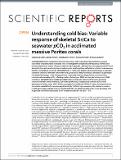Files in this item
Understanding cold bias : variable response of skeletal Sr/Ca to seawater pCO2 in acclimated massive Porites corals
Item metadata
| dc.contributor.author | Cole, Catherine Sarah | |
| dc.contributor.author | Finch, Adrian Anthony | |
| dc.contributor.author | Hintz, Christopher | |
| dc.contributor.author | Hintz, Kenneth | |
| dc.contributor.author | Allison, Nicola | |
| dc.date.accessioned | 2016-06-14T14:30:10Z | |
| dc.date.available | 2016-06-14T14:30:10Z | |
| dc.date.issued | 2016-05-31 | |
| dc.identifier | 242479177 | |
| dc.identifier | fed29785-090a-4838-b9b7-38f3f5e25250 | |
| dc.identifier | 84973366562 | |
| dc.identifier | 000376879100001 | |
| dc.identifier.citation | Cole , C S , Finch , A A , Hintz , C , Hintz , K & Allison , N 2016 , ' Understanding cold bias : variable response of skeletal Sr/Ca to seawater p CO 2 in acclimated massive Porites corals ' , Scientific Reports , vol. 6 , 26888 . https://doi.org/10.1038/srep26888 | en |
| dc.identifier.issn | 2045-2322 | |
| dc.identifier.other | ORCID: /0000-0002-3689-1517/work/38002335 | |
| dc.identifier.other | ORCID: /0000-0003-3720-1917/work/42594133 | |
| dc.identifier.uri | https://hdl.handle.net/10023/8981 | |
| dc.description | This work was supported by the UK Natural Environment Research Council (award NE/I022973/1). | en |
| dc.description.abstract | Coral skeletal Sr/Ca is a palaeothermometer commonly used to produce high resolution seasonal sea surface temperature (SST) records and to investigate the amplitude and frequency of ENSO and interdecadal climate events. The proxy relationship is typically calibrated by matching seasonal SST and skeletal Sr/Ca maxima and minima in modern corals. Applying these calibrations to fossil corals assumes that the temperature sensitivity of skeletal Sr/Ca is conserved, despite substantial changes in seawater carbonate chemistry between the modern and glacial ocean. We present Sr/Ca analyses of 3 genotypes of massive Porites spp. corals (the genus most commonly used for palaeoclimate reconstruction), cultured under seawater pCO2 reflecting modern, future (year 2100) and last glacial maximum (LGM) conditions. Skeletal Sr/Ca is indistinguishable between duplicate colonies of the same genotype cultured under the same conditions, but varies significantly in response to seawater pCO2 in two genotypes of Porites lutea, whilst Porites murrayensis is unaffected. Within P. lutea, the response is not systematic: skeletal Sr/Ca increases significantly (by 2-4%) at high seawater pCO2 relative to modern in both genotypes, and also increases significantly (by 4%) at low seawater pCO2 in one genotype. This magnitude of variation equates to errors in reconstructed SST of up to -5°C. | |
| dc.format.extent | 8 | |
| dc.format.extent | 698960 | |
| dc.language.iso | eng | |
| dc.relation.ispartof | Scientific Reports | en |
| dc.subject | GE Environmental Sciences | en |
| dc.subject | QD Chemistry | en |
| dc.subject | QH301 Biology | en |
| dc.subject | NDAS | en |
| dc.subject | BDC | en |
| dc.subject | R2C | en |
| dc.subject.lcc | GE | en |
| dc.subject.lcc | QD | en |
| dc.subject.lcc | QH301 | en |
| dc.title | Understanding cold bias : variable response of skeletal Sr/Ca to seawater pCO2 in acclimated massive Porites corals | en |
| dc.type | Journal article | en |
| dc.contributor.sponsor | NERC | en |
| dc.contributor.institution | University of St Andrews. School of Earth & Environmental Sciences | en |
| dc.contributor.institution | University of St Andrews. Scottish Oceans Institute | en |
| dc.contributor.institution | University of St Andrews. St Andrews Isotope Geochemistry | en |
| dc.contributor.institution | University of St Andrews. Earth and Environmental Sciences | en |
| dc.contributor.institution | University of St Andrews. Marine Alliance for Science & Technology Scotland | en |
| dc.identifier.doi | https://doi.org/10.1038/srep26888 | |
| dc.description.status | Peer reviewed | en |
| dc.identifier.grantnumber | NE/I022973/1 | en |
This item appears in the following Collection(s)
Items in the St Andrews Research Repository are protected by copyright, with all rights reserved, unless otherwise indicated.

